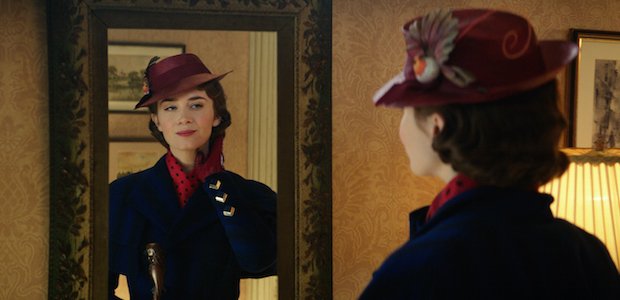There are few films as tender to audiences as 1964's Mary Poppins. It's long been the warm cup of tea with honey prescribed to soften any gloomy day as it effortlessly transports us into its delightful and whimsical world. It serves up a specific spoonful of satisfaction stronger than any of Disney's "happily ever after" stories every time it reaches its bittersweet yet incredibly hopeful "Let's Go Fly a Kite" ending. Its sequel Mary Poppins Returns' greatest achievement is how seamlessly it transports its audiences to the same feeling as the 54-year old original.
During a time when Disney has no longer deemed any of their classics untouchable to another iteration by the studio, Mary Poppins Returns is a guiding light. It's only an imitation in the ways you'd like it to be, as it plays as both a tribute to the original and a long overdue continuation we've been quietly longing for. It has so clearly been carefully placed in the hands of those who loved the original just as much as those most touched by it and knew the practically perfect way to move it along.
Mary Poppins Returns picks up with the Banks children about 25 years after the events of the first film, during London's Depression Era in the mid-1930s. Jane (Emily Mortimer) and Michael Banks (Ben Whishaw) are still on Cherry Tree Lane but since Michael is struggling to raise his three children of his own since his wife's untimely death, Jane is helping out in between her charity and union work. Amid the family's grief, they must also suddenly face financial toils, leading good 'ole Mary (Emily Blunt) to come out of the sky.
In a spit spot, Emily Blunt's Mary Poppins is dazzling the grown-up Banks children, drawing back out their young spirits and soon dazzling a new generation of Banks children. Blunt is a less timid Mary than Julie Andrews was, showing off and adventuring with her magic straightaway. She remarkably creates her own version of Mary while simultaneously having a glimmer of Andrews in her performance that tricks the eye into believing they are one in the same.
Sharing in on the onscreen magic is Lin-Manuel Miranda as Bert's enthusiastic replacement, Jack the lamplighter. He's almost an honorary fourth Banks sibling, considering how youthful and electrified he is by Mary Poppins and the world surrounding the film. He's not the tap-and-dance man or emotional shoulder to the children that Dick Van Dyke's Bert was, but he is the extra pep and ball of energy that the sullen circumstances of the film needs. Miranda burns bright in each and every one of his scenes but sadly just doesn't play a vital role in the plot's core scenes.
Mary Poppins Returns is also blessed with a magnificent supporting casting including Colin Firth as William Weatherall Wilkins, Julie Waters as Ellen, Meryl Streep as Topsy and Angela Lansbury as Balloon Lady. Even Dick Van Dyke makes a stunning comeback that will be an especially sentimental moment for fans of the original. They each uniquely contribute to the classic feel of the film with their performances, though back away at the right times so standouts Emily Blunt and Ben Whishaw can steal the show and give the film its weight.
Mary Poppins Returns also delivers on its completely original music composed by Marc Shaiman and Scott Wittman. It's one of the finest new movie musical arrangements in quite some time, that pulls the best performances out of its cast, adds a certain quirkiness to the film, and flows well with the sort of music we'd expect from a Mary Poppins movie.
The songs do not exactly have the same catchiness that songs like "A Spoonful of Sugar" and "Chim Chim Cher-ee" masterfully got ahold of audiences with. However, like with many musical soundtracks, hear them a bit more and you'll be humming along in no time. Mary Poppins Returns also takes great advantage of the visual advancements in film since the '60s to enhance the incredible cinematic achievements Mary Poppins pulled off then, including a beautiful live-action/animation hybrid sequence, a completely CGI scene blended with stagey large scale song-and-dance musical numbers.
The backbone of the plot is considerably close to the original, making it feel quite close to a remake but since it's the first go at a retelling and it is so beloved, I believe it was the right choice to recycle some of the storyline. Mary Poppins Returns tackles some strong themes of loss and what it means to grow up, but not too intensely or maturely. As the original did so gracefully, it's one of those films that somehow can offer a different message to a range of audiences-- it's not just a "kids movie" or a fix of nostalgia, it's a radiant timeless tale audiences will long to fly with again and again.

Sarah El-Mahmoud has been with CinemaBlend since 2018 after graduating from Cal State Fullerton with a degree in Journalism. In college, she was the Managing Editor of the award-winning college paper, The Daily Titan, where she specialized in writing/editing long-form features, profiles and arts & entertainment coverage, including her first run-in with movie reporting, with a phone interview with Guillermo del Toro for Best Picture winner, The Shape of Water. Now she's into covering YA television and movies, and plenty of horror. Word webslinger. All her writing should be read in Sarah Connor’s Terminator 2 voice over.











